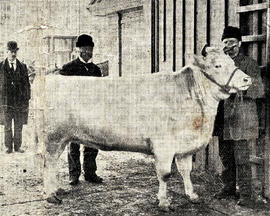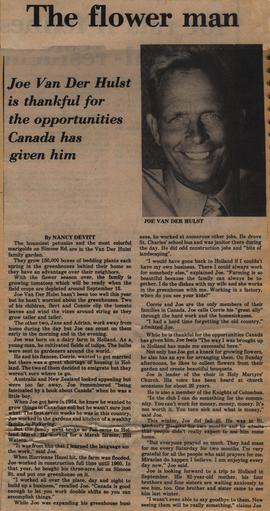- CA BWGPL VS-1900-24597
- Item
- 1975-10-22
Parte de Vital Statistics
Event Date : Friday, October 17, 1975
Event Type : Death
Description : Vic Turner, veteran councillor and past reeve of West Gwillimbury, died at his home in Bradford on Friday, October 17, at age 85. Mr. Turner, whose son Art is now Reeve of Bradford, came to Canada in 1907 at the age of 16. He came alone, leaving behind his family in South Chinford, just outside London. Mr. Turner first came to Toronto, then moved up to Bradford where he worked on the Pulford family farm on the 12th Line of West Gwillimbury. Bobby Pulford, a son of the family, is now coach of the Los Angeles Rams. After taking jobs in Toronto and in the west of Canada, Mr. Turner moved back to West Gwillimbury and farmed there for many years. He married three times, his first wife being Esther Brown; his second marriage to Elizabeth Riley was in August 1921. During their long marriage, the Turners farmed locally, then moved to Bradford in 1949. The second Mrs. Turner died in 1962. In 1963, Mr. Turner married for a third time, to Irene Brown of West Gwillimbury. Mr. Turner is survived by five children: Mrs. Margaret Summerville of Guelph, Bruce Turner of Kemptville near Ottawa, Art Turner of Bradford, Doug Turner of Timmins and Mrs. Dorothy Hodgson of Thunder Bay; and by 11 grandchildren and 7 great-grandchildren. Mr. Turner first became involved in local politics when he became a councillor in West Gwillimbury around 1937. He stayed on council becoming reeve in 1946 and holding this position in 1947 and '48.Mr. Turner left active politics and worked for Holland River Gardens (now Hardee Farms) following this. He retired from work seven years ago. While working at Hardee, Mr. Turner was appointed to the Bradford Public Utilities Commission in 1951. Appointment to the commission was then a council decision and not an elected post. Mr. Turner's proudest achievement was opening up Simcoe Road to the marsh and pushing for a bridge to be built linking the marsh to the main Bradford area, thus making it possible for the marsh to be developed for commercial farming. While serving on the Public Utilities Commission, Mr. Turner was instrumental in the decision to buy the present PUC building on Barrie Street. Mr. Turner was also involved in the Bradford Masonic Lodge, but his main interest all his life was in the marsh and the people living and farming it. The funeral service was held at the chapel of the Lathangue & Skwarchuk Funeral Home, Simcoe St., Bradford, followed by burial at Mount Pleasant Cemetery, Monday, October 20.
Sem título



